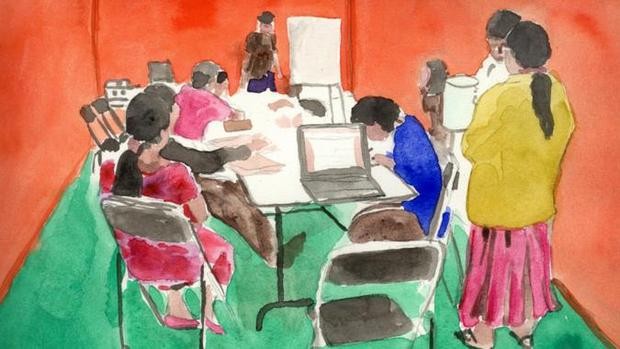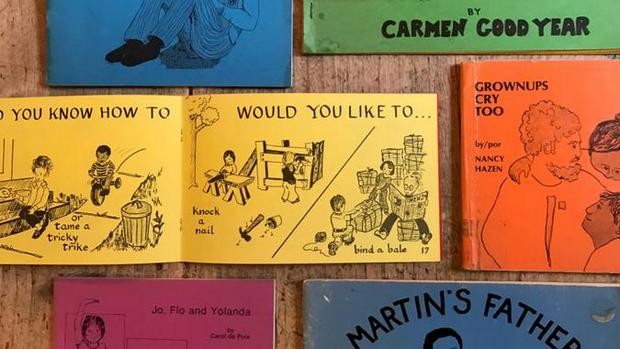Forms of Action
27 Jan - 12 Mar 2017

Katia Kameli, The Lion, Mask study for Stream of Stories, paper and cardboard, 2015. Courtesy of the artist
FORMS OF ACTION
27 January – 12 March 2017
Kim Dhillon, Adelita Husni-Bey, Daniel Godínez Nivón, Katia Kameli, Dimitri Launder, Victoria Lomasko, Asunción Molinos Gordo
Forms of Action will explore current international developments in socially engaged art practices, looking at both form and content. It also aims to present a diverse series of approaches that transform spectatorship and the role of artists in society. This exhibition forms part of a significant shift from a more traditional understanding of art and its usual environment, in to an understanding of art in the cut and thrust of ordinary life. As this takes place, it is beginning to influence a genuine change in art practice.
In that very spirit, the exhibition will underline the validity of these approaches as artistic projects in themselves, and not solely as social development strategies. Participating artists will address a diverse range of issues, including, but not limited to, the socio-cultural implications of food and agriculture; second wave feminism; material studies; written language and radical gardening, using storytelling, sound, photography, performance, graphic reportage and other creative interventions. The exhibition seeks not to document outcomes, but rather, illustrate practices. The main focus of Forms of Action is the implementation of art and creativity as a way to address issues in society. Art becomes the ‘how’ to transform reality rather than the ‘what’ to be delivered to specific audiences.
CCA is currently expanding its institutional vision to repurpose itself according to the emerging urgencies related to engagement. Our first priority is to merge different visions coming from around the world, and create temporary, but significant, platforms where a fruitful cultural exchange can be achieved.
Forms of Action will retain many of the usual parameters of a traditional exhibition, in order to give focus to artistic approaches that reflect the changing dynamics between art and society. It seeks to present the connection between art and society as a valuable source for all involved: artists, curators, and public audiences, and for the future development of art practice in general.
Forms of Action’s main interest is in civic commitment rather than in the dispensation of concrete solutions. Our goal is to interrogate our current condition by asking how art can be used as a socially motivated and motivating tool for change.
27 January – 12 March 2017
Kim Dhillon, Adelita Husni-Bey, Daniel Godínez Nivón, Katia Kameli, Dimitri Launder, Victoria Lomasko, Asunción Molinos Gordo
Forms of Action will explore current international developments in socially engaged art practices, looking at both form and content. It also aims to present a diverse series of approaches that transform spectatorship and the role of artists in society. This exhibition forms part of a significant shift from a more traditional understanding of art and its usual environment, in to an understanding of art in the cut and thrust of ordinary life. As this takes place, it is beginning to influence a genuine change in art practice.
In that very spirit, the exhibition will underline the validity of these approaches as artistic projects in themselves, and not solely as social development strategies. Participating artists will address a diverse range of issues, including, but not limited to, the socio-cultural implications of food and agriculture; second wave feminism; material studies; written language and radical gardening, using storytelling, sound, photography, performance, graphic reportage and other creative interventions. The exhibition seeks not to document outcomes, but rather, illustrate practices. The main focus of Forms of Action is the implementation of art and creativity as a way to address issues in society. Art becomes the ‘how’ to transform reality rather than the ‘what’ to be delivered to specific audiences.
CCA is currently expanding its institutional vision to repurpose itself according to the emerging urgencies related to engagement. Our first priority is to merge different visions coming from around the world, and create temporary, but significant, platforms where a fruitful cultural exchange can be achieved.
Forms of Action will retain many of the usual parameters of a traditional exhibition, in order to give focus to artistic approaches that reflect the changing dynamics between art and society. It seeks to present the connection between art and society as a valuable source for all involved: artists, curators, and public audiences, and for the future development of art practice in general.
Forms of Action’s main interest is in civic commitment rather than in the dispensation of concrete solutions. Our goal is to interrogate our current condition by asking how art can be used as a socially motivated and motivating tool for change.




